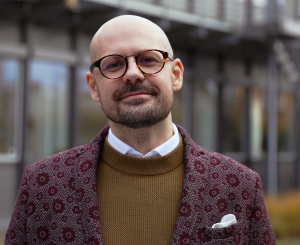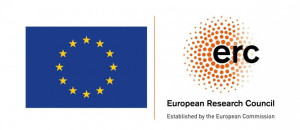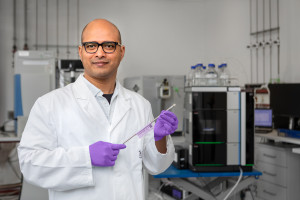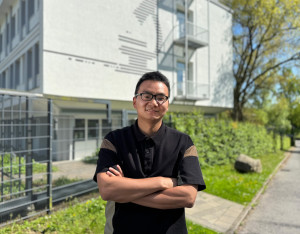Dortmund, 14th May 2025
Prof Dr Miloš Filipović joined ISAS in October 2020, after moving his ERC group Sulfaging from Bordeaux, France to Dortmund. His EU-funded research focusses on the connection between ageing processes and gasotransmitter signaling, hydrogen sulfide (H₂S) in particular. In 2024, the 42-year-old accepted an offer for a full professorship for Molecular Biosciences at the University of Glasgow, Scotland. As he has left ISAS in spring 2025, this poses a fitting occasion to reflect on the past four years and review his time at the institute in a short interview.
What was you most memorable finding in the past four years?
Filipović: In 2024, we submitted a paper on the molecular mechanism of ergothioneine, a compound found in mushrooms. Our results hint that it elongates the health span of ageing animals through provision of H₂S, which protects cells from oxidative stress through the process of persulfidation (see infobox). It’s an interesting story because it started more as a backup plan for a thesis, where a couple of things didn’t work as planned. Out of necessity, we had to come up with something quick and had no high expectations at all. It somehow just perfectly landed in our laps, as the whole mechanism turned out to be right within our area of expertise. We already had the network and the resources to get to work right away. It was really all kind of serendipity in a way and quite unusual.

Prof Dr Miloš Filipović was a group leader at ISAS from October 2020 to February 2025. Since March 2025 he has been teaching and researching at the University of Glasgow, Scotland.
© ISAS
Persulfidation
Persulfidation is a posttranslational modification in which a persulfide group (-SSH) is added to the thiol side chain of cysteine residues in proteins. This process is triggered by hydrogen sulfide (H₂S), a gasotransmitter that acts as a signaling molecule in the body. Persulfidation can regulate protein activity, protect cells from oxidative stress, and is involved in anti-inflammatory and neuroprotective processes.
How would you describe your research at ISAS?
Filipović: I would say curiosity driven. We don't necessarily stick into one frame, and we also don't stick to one method. I mean, if we don't have a method and can’t find it somewhere else in the world, we’ll develop a method! During our time here we have looked at some cardiovascular aspects, like myocardial ischaemia–reperfusion injury, hemorrhagic shock and so on. With ergothioneine we have these exercise models, and ageing. We’ve also been looking at neurodegeneration, particularly Alzheimer’s disease models. Mechanistically, all of these topics came from our area of expertise, meaning those post-translational modifications, particularly of cysteines. But also, they are very distinct stories.
Part of the goal of the institute is to standardise the measurements, and for that you want the whole process done in the most precise and clean way. This approach has probably shaped my work forever.
Which techniques have shaped your time here?
Filipović: Mass spectrometry as such is something that we learned at ISAS. It is a broad term, but we use different types of mass spectrometry in our research. Some of them we adapted from the literature and so on, but none of that would have been possible if we didn't have access to all these instruments on such a regular basis. In most institutions you give your samples to the facility and then get back the results. Because unlike at ISAS, you don't do it by yourself every single step, from the sample preparation to measurement to data analysis, you don't have actual hands-on experience of what can go wrong and why the measurement didn't work out. Being skilled in all necessary steps is a huge advantage when it comes to problem solving.
After I came here, my whole view on mass spectrometry, specifically proteomics, changed in a way. For example, at ISAS every sample goes to quality control before it's measured. That extra step helps all the devices run smoothly for a long time, without a technician having to clean the instrument every three months and stopping the workflow. What seems like a standard procedure, is quite unusual as it takes extra time. But is has benefits: Part of the goal of the institute is to standardise the measurements, and for that you want the whole process done in the most precise and clean way. This approach has probably shaped my work forever.
In March 2025 you transfered to the School of Molecular Bioscience at the University of Glasgow as a full professor. What are your plans for the new position?
Filipović: Besides doing research, I’ll also be teaching in Glasgow. That’s exciting and a new challenge, I’m happy to take on. Of course I’m going to stay in touch with ISAS, we already have some collaborative projects planned with the Cardiovascular Pharmacology research group. We developed a concept how persulfidation affects phase separation and aggregation in the ageing brain, that we plan to expand to the heart, specifically in the context of amyloidosis.
(The interview was conducted by Cheyenne Peters)

Sulfaging has received funding from the European Research Council (ERC) under the European Union’s Horizon 2020 research and innovation programme (grant agreement No. 864921).








